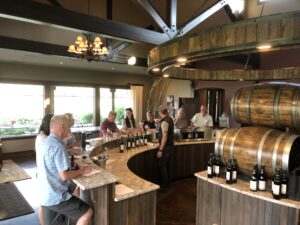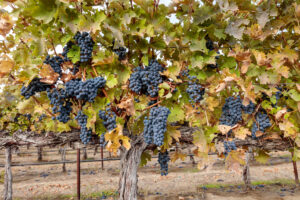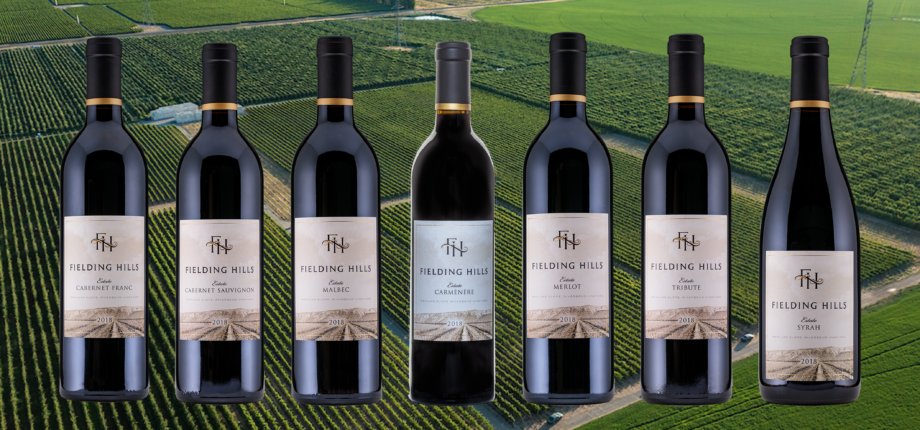Posted: September 10th, 2021
We are grateful for the opportunity to welcome guests into the tasting room and resume hosting events over the last year. The chance to gather and share a glass of wine with you is an honor. Vital to sharing our wines with you is the team of people, from dirt to glass, who create the resulting wine. Some of their names and faces you may know well. We are thankful to the entire team at Fielding Hills Winery who create exceptional wines and an experience to match.

Fielding Hills Winery Staff tasting of the 2018 Vintage, guided by winemaker Tyler Armour
In preparation for sharing these wines, our team got together and tasted through the 2018 vintage. Together, we tasted:
2018 Estate Cabernet Sauvignon – 561 cases – 91 pts, Editors’ Choice – Wine Enthusiast
77% new oak | 23% used once filled oak (one vintage, i.e. 22 months)
85% French oak | 15% Hungarian oak
19% of finished wine was aged in 500L puncheons
2018 Estate Cabernet Franc – 343 cases – 90 pts– Wine Enthusiast
38% new oak | 62% used once filled oak
86% French oak | 14% Hungarian oak
16% of finished wine was aged in 500L puncheons
2018 Estate Syrah – 534 cases – 91 pts– Wine Enthusiast
62% new oak | 38% used once filled oak
95% French oak | 5% American oak
44% of finished wine was aged in 500L puncheons
14% of finished wine was fermented whole cluster
2018 Estate Malbec – 328 cases
42% new oak | 58% used once filled oak
85% French oak | 15% Hungarian oak
17% of finished wine was aged in 500L puncheons
2018 Estate Tribute – Red Wine – 514 cases – 90 pts– Wine Enthusiast
22% new oak | 78% used once filled oak
88% French oak | 12% American oak
56% of finished wine was fermented and aged in a 30hL (800gal) French oak tank
2018 Estate Carmenere – 37 cases – 90 pts– Wine Enthusiast
59% new oak | 41% used once filled oak
100% French oak
2018 Estate Merlot – 168 cases – 90 pts– Wine Enthusiast
78% new oak | 22% used once filled oak
70% French oak | 30% American oak
22% of finished wine was fermented and aged in a 30hL (800gal) French oak tank
A large focus during our tasting was the impact that barrels have during the winemaking process. Specifically, we discussed the various aromas we were picking out and which of our barrels could have contributed that. Here is a great article from Wine Folly, that does a deep dive into the magic of barrel aging. We also spent time reflecting on the stellar growing season and harvest we experienced in 2018. Below is a brief highlight of the growing season and subsequent production process through the 2018 vintage…
No frost or freeze damage was recorded at the vineyards. Cooler weather in April (one of the coldest Aprils on record) put the vines behind by a week or two, but a warmer than average May (one of the warmest Mays on record) got the vines back on track with historical averages.

Early October Cabernet Sauvignon vines from our Estate Riverbend Vineyard in the Wahluke Slope AVA
Pick decisions are based equally on grape juice chemistry (Brix/pH/TA), as well as flavor and physical maturity of the grapes. Harvested early in the morning, the hand-picked grapes are delivered to the winery for immediate processing. Whole-cluster sorted to remove any material other than grapes (MOG), before being destemmed and hand sorted again to remove any remaining non-grape material. Fermented in a combination of 1-ton fermenters, and 3 ton French oak tanks. The must is allowed to rest for 24 hours before inoculation with a selected yeast strain. The must is gently punched-down twice daily to ensure proper phenolic extraction. When fermentation is nearly complete the free-run wine is pumped directly into French and American oak barrels, mostly being 225L with some 500L French oak puncheons used on the Cabernet Sauvignon, Cabernet Franc, and Syrah. Fielding Hills Winery uses approximately 85% French oak and 15% American oak, varying slightly with each varietal; 65% new oak and 35% once-filled barrels. Barrel aged 22 months, followed by another year in bottle before release.
